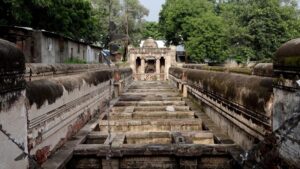This 500-year-old stepwell descends seven levels deep into the ground.
Just off a main road, nestled among unassuming small businesses, the Sevasi Vav, or stepwell, might be missed if you are not looking for it. This stepwell dates from the mid-15th century and is located just a few miles from Vadodara city’s center.
Historically, Indian stepwells served multiple purposes. The wells were dug deep, several stories into the ground, to access fresh groundwater. In addition, the wells filled up many levels when the region was inundated with rain during the monsoon season. This was critical, particularly in the arid regions of Western India, as it helped to offset water scarcity throughout the rest of the year. Stepwells naturally became places to gather, to seek rest and shade, and make religious offerings.
Sevasi Vav is a beautiful example of a stepwell, but it is not very well known. Unlike many stepwells that were built as part of large palace complexes, this stepwell simply served the local village. The name Sevasi translates roughly as “service,” the well was built in honor of a spiritual leader from the area. It is ornately carved along the walls and pillars of its interior.
Small altars with colorful flowers encourage visitors to slow down and appreciate the view while descending. The temperature is noticeably cooler, the air darker, and sounds echo in the quiet. It feels far away from the bustle of the road above. The architecture of the stepwell is angular and symmetrical, a sculptural grid above a wide set of steps. The Vav had long fallen out of use, and upkeep was minimal for many years, but it has recently come under the care of a charitable trust that plans to restore the site and incorporate community programming.
Know Before You Go
Entrance to the stepwell is free.
